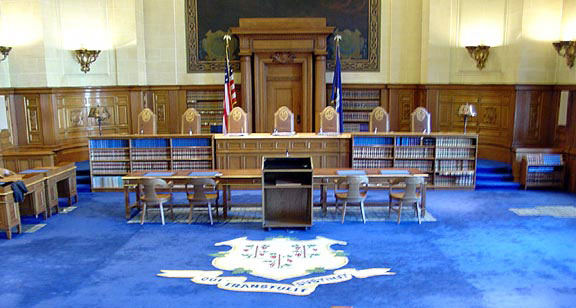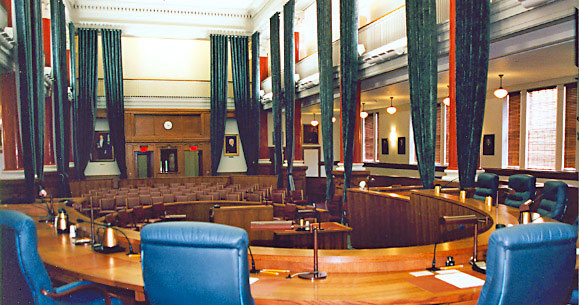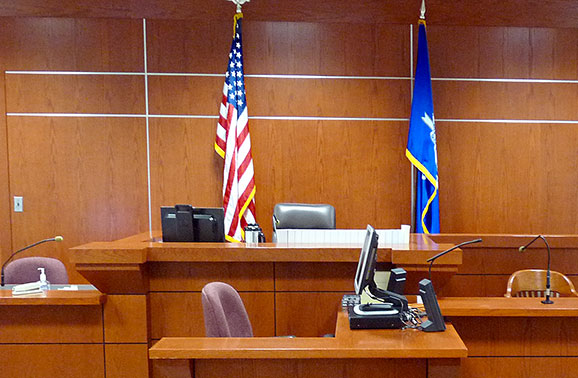About Connecticut Courts
The Supreme Court is the state's highest court. It consists of
the Chief Justice and six associate justices. In addition, justices who are
eligible and who have not yet attained the age of 70 may elect to take
senior status and remain as members of the court.
 A panel of five justices hears
and decides each case. On occasion, the Chief Justice summons the court to
sit en banc as a full court of seven, instead of a panel of five, to hear
particularly important cases.
A panel of five justices hears
and decides each case. On occasion, the Chief Justice summons the court to
sit en banc as a full court of seven, instead of a panel of five, to hear
particularly important cases.
The Supreme Court reviews decisions
made in the Superior Court to determine if any errors of law have been
committed. It also reviews selected decisions of the Appellate Court.
Generally, the Supreme Court does not hear witnesses or receive evidence. It decides each case on:
- the record of lower court proceedings;
- briefs, which are used by counsel to convey to the court the essential points of each party's case; and,
- oral argument based on the content of the briefs.
State law specifies which types of appeals may be brought
directly to the Supreme Court from the Superior Court, thereby bypassing the
Appellate Court. These cases include: decisions where the Superior Court has
found a provision of the state constitution or a state statute invalid and
convictions of capital felonies. All other appeals are brought to the
Appellate Court.
The Supreme Court may transfer to itself any matter
filed in the Appellate Court, and may agree to review decisions of the
Appellate Court through a process called certification. Except for any
matter brought under its original jurisdiction, as defined by the State
Constitution, the Supreme Court may transfer any matter pending before it to
the Appellate Court.
Appellate Court
-
History of the
Appellate Court
- PDF
The Appellate Court, like the Supreme Court,
reviews decisions made in the Superior Court to determine if errors of law
have been committed.
There are nine Appellate Court judges, one of
whom is designated by the Chief Justice to be Chief Judge.
 In addition,
judges who are eligible and who have not attained the age of 70 may elect to
take senior status and remain as members of the court. Generally,
three judges hear and decide each case, although the court may also sit en
banc, which means that the entire membership of the court participates in
the decision.
In addition,
judges who are eligible and who have not attained the age of 70 may elect to
take senior status and remain as members of the court. Generally,
three judges hear and decide each case, although the court may also sit en
banc, which means that the entire membership of the court participates in
the decision.
Like the Supreme Court, the Appellate Court does not
hear witnesses, but renders its decision based upon the record, briefs and
oral argument.
Superior
Court
- The Superior Court hears all legal controversies except those
over which the Probate Court has exclusive jurisdiction. Probate Court
matters may be appealed to the Superior Court.
 The state is divided
into 13 judicial districts, 20 geographical areas and 12 juvenile districts.
In general, major criminal cases, civil matters and family cases not
involving juveniles are heard at judicial district court locations. Other
civil and criminal matters are heard at geographical area locations. Cases
involving juveniles are heard at juvenile court locations.
The state is divided
into 13 judicial districts, 20 geographical areas and 12 juvenile districts.
In general, major criminal cases, civil matters and family cases not
involving juveniles are heard at judicial district court locations. Other
civil and criminal matters are heard at geographical area locations. Cases
involving juveniles are heard at juvenile court locations.
The Superior
Court has four principal trial divisions: civil, criminal, family and
housing.
Civil Division - A civil case is usually a matter in which one
party sues another to protect civil, personal or property rights. Examples
of typical civil cases include landlord-tenant disputes, automobile or
personal accidents, product or professional liability suits and contract
disputes. In most civil cases, the accusing party (plaintiff) seeks to
recover money damages from another party (defendant). Cases may be decided
by the judge or by a jury, depending on the nature of the claim and the
preference of the parties.
Criminal Division - A criminal case is one in
which a person (defendant) is accused of breaking the law. The two sides in
a criminal case are the state, represented by a state's attorney (because
crimes are considered acts that violate the rights of the entire state), and
the defendant. Crimes (felonies and misdemeanors), violations and
infractions are heard in the Criminal Division.
Housing Division - Cases
involving housing are heard in special housing sessions in the Bridgeport,
Hartford, New Haven, Stamford-Norwalk and Waterbury judicial districts. In
all other judicial districts, these cases are part of the regular civil
docket.
Family Division - The Family Division is responsible for the
just and timely resolution of family relations matters and juvenile matters.
Examples of family relations matters include: dissolution of marriage, child
custody, relief from abuse and family support payments. Juvenile matters
include: delinquency, child abuse and neglect, and termination of parental
rights.
Probate Court
- In addition
to the state-operated courts, Connecticut has probate courts, which have
jurisdiction over the estates of deceased persons, testamentary trusts,
adoptions, conservators, commitment of the mentally ill, guardians of the
persons, and estates of minors. Each Probate Court has one judge, who
is elected to a four-year term by the electors of the probate district.
There are 54 Probate Court districts and six Regional Children’s Probate
Courts. State law requires that probate judges be attorneys, and they are
paid through a statutory formula. Probate Courts are housed in municipal
facilities, most often town and city halls.
Top